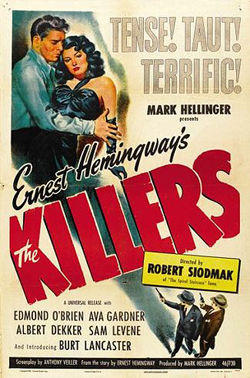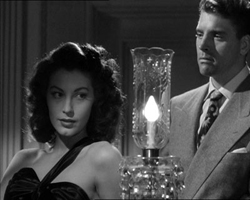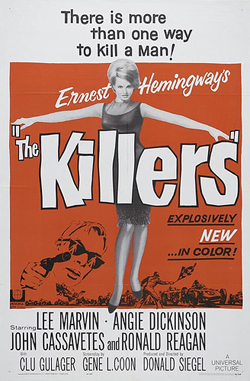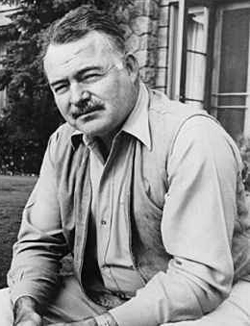
Thus it’s only natural that a Hemingway credit on a couple of mid-century films—both called The Killers and purportedly based on Hemingway’s short story of the same name—could be counted on to bring out the crowds.
“The Killers” is one of Hemingway’s Nick Adams stories, Nick Adams being Hemingway’s fictional alter ego. In the story, Nick is sitting at a lunch counter when two mysterious men enter. They are identically dressed in dark overcoats, derby hats, silk mufflers, and gloves. Repeating the sarcastic refrain “bright boy” over and over, they bait the proprietor, George, about his menu offerings, about the fact that his clock is twenty minutes fast, about the unavailability of liquor in his establishment, then they turn their attentions to Nick. Eventually they tie Nick and the cook up in the kitchen, warning George to send away any potential diners. They are waiting for Ole Andreson, a “big Swede,” who eats dinner there every night at six. Hemingway creates an atmosphere of thoroughgoing menace, punctuated by an almost Monty Python-esque humor.
The men plan to kill Andreson when he arrives—they are doing it “for a friend.” By seven p.m., he has not arrived. The men wait a bit longer and then leave. Nick goes to Andreson’s rooming house to warn him, at which point we learn that Andreson is a former prize fighter. Nick relays his news, but Andreson says there is nothing he can do. Back at the diner, Nick reports on his errand and announces he is going to get out of town, commenting, “I can’t stand to think about him waiting in the room and knowing he’s going to get it. It’s too damned awful.” George tells him not to think about it. And that’s the end of the story.

The 1946 film is a bona fide whodunit in the noir tradition. Hemingway’s terse style and nihilistic worldview certainly lend themselves to noir treatment, but I’m not sure the back story Veiller came up with for Andreson is exactly what Hemingway imagined. Our sleuth is a life insurance investigator who is pulled into the story because he needs to track down the beneficiary of the Swede’s insurance policy. He learns that the Swede had to leave boxing because of an injury and was recruited to be part of a payroll robbery. Ava Gardner—Kitty—is the girlfriend of the gangster masterminding the robbery, but she’s attracted to the Swede—and who wouldn’t be? The gang plans to double-cross him and make off with his share of the loot but Kitty warns him and he snatches all the money ($250,000) instead. Then Kitty snatches the money from him. Complication piles upon complication and body piles upon body, and the takeaway is that you just can’t trust dames.

Boxing wasn’t as glamorous in 1964 as it had been in 1946. So the Swede, who is no longer a Swede, has been transmogrified into . . . a racecar driver! And Angie Dickinson plays Sheila Farr, a chick who gets off on fast men and fast cars. The lunch counter has vanished. In its place we have a home for the blind. Our bad guys, played by Lee Marvin as a sort of elder statesman of hit men and Clu Gulager as a cheerful sociopath, show up in search of Johnny North (Cassavetes). They terrorize the blind receptionist and track North to the classroom where he’s patiently teaching a bunch of blind people to identify the parts of an engine. Even though one of the home’s inhabitants manages to warn him that he’s in danger, he meets his fate stoically, seeming almost glad to die.

Peggy Ehrhart is the author of the Maxx Maxwell mysteries, featuring blues-singer sleuth Elizabeth “Maxx” Maxwell. Visit Peggy on the web at www.PeggyEhrhart.com.

I love the posters. Just awesome.
Great post, Peggy. I love these noir films and Hemingway was nothing if not dark!
Thanks for the comments! The Wikipedia article on the first film version of “The Killers” quotes one of Hemingway’s biographers, Carlos Baker, as reporting that it “was the first film from any of his works that Ernest could genuinely admire”–kind of funny, since only the very beginning of the film actually derived from his own work. And, yes, the posters are incredible. Bra technology was obviously very different back then.